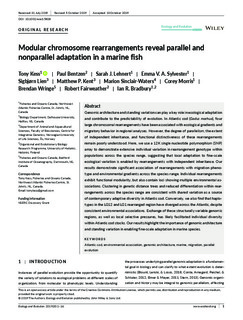| dc.contributor.author | Kess, Tony | |
| dc.contributor.author | Bentzen, Paul | |
| dc.contributor.author | Lehnert, Sarah | |
| dc.contributor.author | Sylvester, Emma V. A. | |
| dc.contributor.author | Lien, Sigbjørn | |
| dc.contributor.author | Kent, Matthew Peter | |
| dc.contributor.author | Sinclair-Waters, Marion | |
| dc.contributor.author | Morris, Corey | |
| dc.contributor.author | Wringe, Brendan | |
| dc.contributor.author | Fairweather, Robert | |
| dc.contributor.author | Bradbury, Ian R. | |
| dc.date.accessioned | 2020-01-29T12:18:00Z | |
| dc.date.available | 2020-01-29T12:18:00Z | |
| dc.date.created | 2020-01-23T15:52:42Z | |
| dc.date.issued | 2019 | |
| dc.identifier.citation | Ecology and Evolution. 2020 | nb_NO |
| dc.identifier.issn | 2045-7758 | |
| dc.identifier.uri | http://hdl.handle.net/11250/2638598 | |
| dc.description.abstract | Genomic architecture and standing variation can play a key role in ecological adaptation and contribute to the predictability of evolution. In Atlantic cod (Gadus morhua), four large chromosomal rearrangements have been associated with ecological gradients and migratory behavior in regional analyses. However, the degree of parallelism, the extent of independent inheritance, and functional distinctiveness of these rearrangements remain poorly understood. Here, we use a 12K single nucleotide polymorphism (SNP) array to demonstrate extensive individual variation in rearrangement genotype within populations across the species range, suggesting that local adaptation to fine‐scale ecological variation is enabled by rearrangements with independent inheritance. Our results demonstrate significant association of rearrangements with migration phenotype and environmental gradients across the species range. Individual rearrangements exhibit functional modularity, but also contain loci showing multiple environmental associations. Clustering in genetic distance trees and reduced differentiation within rearrangements across the species range are consistent with shared variation as a source of contemporary adaptive diversity in Atlantic cod. Conversely, we also find that haplotypes in the LG12 and LG1 rearranged region have diverged across the Atlantic, despite consistent environmental associations. Exchange of these structurally variable genomic regions, as well as local selective pressures, has likely facilitated individual diversity within Atlantic cod stocks. Our results highlight the importance of genomic architecture and standing variation in enabling fine‐scale adaptation in marine species. | nb_NO |
| dc.language.iso | eng | nb_NO |
| dc.publisher | John Wiley & Sons | nb_NO |
| dc.rights | Navngivelse 4.0 Internasjonal | * |
| dc.rights.uri | http://creativecommons.org/licenses/by/4.0/deed.no | * |
| dc.title | Modular chromosome rearrangements reveal parallel and nonparallel adaptation in a marine fish | nb_NO |
| dc.type | Journal article | nb_NO |
| dc.type | Peer reviewed | nb_NO |
| dc.description.version | publishedVersion | nb_NO |
| dc.source.journal | Ecology and Evolution | nb_NO |
| dc.identifier.doi | 10.1002/ece3.5828 | |
| dc.identifier.cristin | 1781074 | |
| dc.description.localcode | © 2019 The Authors. Ecology and Evolution published by John Wiley & Sons Ltd. This is an open access article under the terms of the Creative Commons Attribution License, which permits use, distribution and reproduction in any medium, provided the original work is properly cited. | nb_NO |
| cristin.unitcode | 194,66,20,0 | |
| cristin.unitname | Institutt for fysikk | |
| cristin.ispublished | true | |
| cristin.qualitycode | 1 | |

